Record Number of Social and Environmental Shareholder Resolutions Filed in 2014
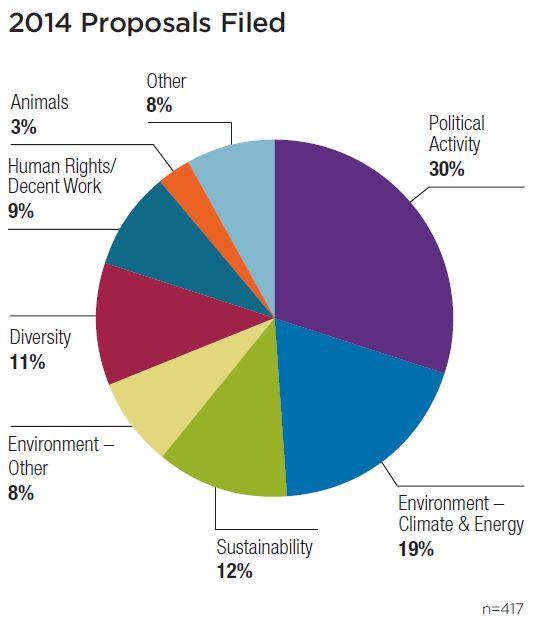

By Andrew Behar
As the 2014 proxy season takes shape, more investors than ever are seeking transformation of corporate environmental, social and governance (ESG) policies. A record-breaking 417 social and environmental shareholder resolutions have been filed so far this proxy season, with political spending and climate change driving the majority of the activity.
This year we have broken every record on the number of resolutions filed, and over the past decade the average vote in support of social and environmental resolutions has nearly doubled. Shareholders today are looking not at these issues in isolation. Instead, they articulate a systemic critique, pointing out the connections between excessive political spending, inadequate energy policy, the dangers of our changing climate and its damaging impact on water and agriculture, toxic hazards, and how these are related to human rights.
Investors' strong demand for more disclosure of corporate political spending before and after elections account for almost a third of shareholder ESG resolutions. Proposals on climate change, energy, and their related risks — as well as interconnected questions about corporate sustainability strategies and transparency — have also grown, and account for about another 40 percent of the 417 resolutions filed to date. Human rights and diversity on boards and in the workplace make up most of the rest.
The flood of corporate political activity proposals continues unabated, and it's not just looking at electoral spending. A broad coalition of investors want companies to tell stockholders and the public more about what they spend before and after elections, both directly and most particularly through intermediary groups responsible for what some term "dark money" in the public influence game. The corporate political activity disclosure campaign has broadened in the last three years with an array of suggested responses to the new spending landscape opened up by the 2010 Citizens United U.S. Supreme Court decision. In the backdrop of this year’s shareholder campaign, further big modifications of campaign finance law may come any day from the court in McCutcheon v. FEC.
Resolutions on climate change and environmental issues are the second largest category of proposals filed. Investors are demanding greenhouse gas emissions reductions and disclosure. New carbon asset risk resolutions are asking companies if they are prepared to succeed in an increasingly carbon constrained world, amid fears of stranded carbon assets and the potential of a carbon bubble. The exploding shale energy business has intensified concerns about methane emissions, a far more potent greenhouse gas than carbon dioxide.
This proxy season looks to be exciting and dynamic as issues that have been simmering over the past few years come to a full boil. Extreme weather and extreme politics are spawning extreme advocacy, while at the same time more and more companies are sitting down with their investors and finding common ground on the critical issues of our time.
Learn more about the issues investors have raised with their companies this proxy season in Proxy Preview 2014, a report As You Sow publishes annually with the Sustainable Investments Institute and Proxy Impact. Proxy Preview 2014 is the 10th edition of the report hailed as the "Bible for socially progressive foundations, religious groups, pension funds, and tax-exempt organizations" by the Chicago Tribune. Proxy Preview assesses the shareholder resolutions, how companies are responding, and policy changes affecting the proposals at the Securities and Exchange Commission (SEC).
Andrew Behar is the CEO of the As You Sow Foundation (www.asyousow.org), a nonprofit organization dedicated to increasing corporate environmental and social responsibility.
Wind Energy Protects Water Security, Says Report
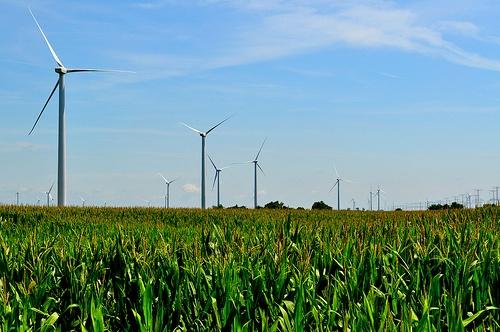

Just in time for World Water Day: The European Wind Energy Association has released a report examining the role that water plays in energy production. And the numbers are staggering.
According to the report, 44 percent of water usage in the European Union goes to energy production. That includes coal, nuclear, biofuels and natural gas, Europe’s four thirstiest energy industries. That’s almost half what is used in the next largest sector, agriculture, which is 24 percent.
Statistics released by the Union of Concerned Scientists paint a similar picture regarding U.S. usage, says the American Wind Energy Association. Between 60 and 170 billion gallons are withdrawn from lakes, rivers and other essential water sources every day for thermoelectric plants, whose temperatures are regulated by water. Although the amount that is actually consumed (lost) only ranges between 2.8 and 5.8 billion gallons, that still is significant, says the UCS.
“U.S. power plants withdrew enough freshwater each day in 2008 to supply 60 to 170 cities the size of New York.”
At a time when water security is a growing concern throughout the world, these are huge implications to consider, says the EWEA.
“In 2012, [wind] energy avoided the use of 1.2 billion m³ (317 billion gallons) of water in 2012, equivalent to the average annual household water use of 22 million EU citizens.” the EWEA says.
The AWEA has done its own calculations on the savings that were made from 140 million MWh of wind-generated power in the U.S. More than 30 billion gallons of water was saved using wind power that year instead of fossil-fuel generated power. That’s 97 gallons for every person in the U.S.
And last year’s savings? According to the AWEA’s website, the wind projects that were funded in part by tax credits under the American Recovery and Reinvestment Act Section 1603 in 2012 saved an estimated 35 billion gallons of water, or 120 gallons per person, in 2013.
“The power sector withdraws more water than any other sector in the United States, including the agricultural sector,” says the AWEA. “By displacing electricity generation from other sources, wind energy not only avoids CO2 emissions and pollutants, but also avoids water withdraws and consumption, preserving the water for other uses."
Interestingly, no specific data was provided by either wind energy organization about the cost of water in hydraulic fracturing, which is outside the boundaries of the EWEA’s study, but would significantly add to withdrawal and consumption costs of producing energy from fossil fuels.
With World Water Day 2014 upon us (March 22), the implications of impending water shortages from climate change go beyond the question of the creature comforts of a developed nation such as daily showers, clean dishes and a vibrant garden. According to the EWEA and AWEA’s stats, conserving our water sources may soon become even more challenging in the face of a growing demand for energy generation to meet a growing world population. Wind and other renewable sources are looking better and better.
Illinois wind farm: Shock264
Is Palm Oil-Driven Deforestation the Secret Ingredient in Your Favorite Products?
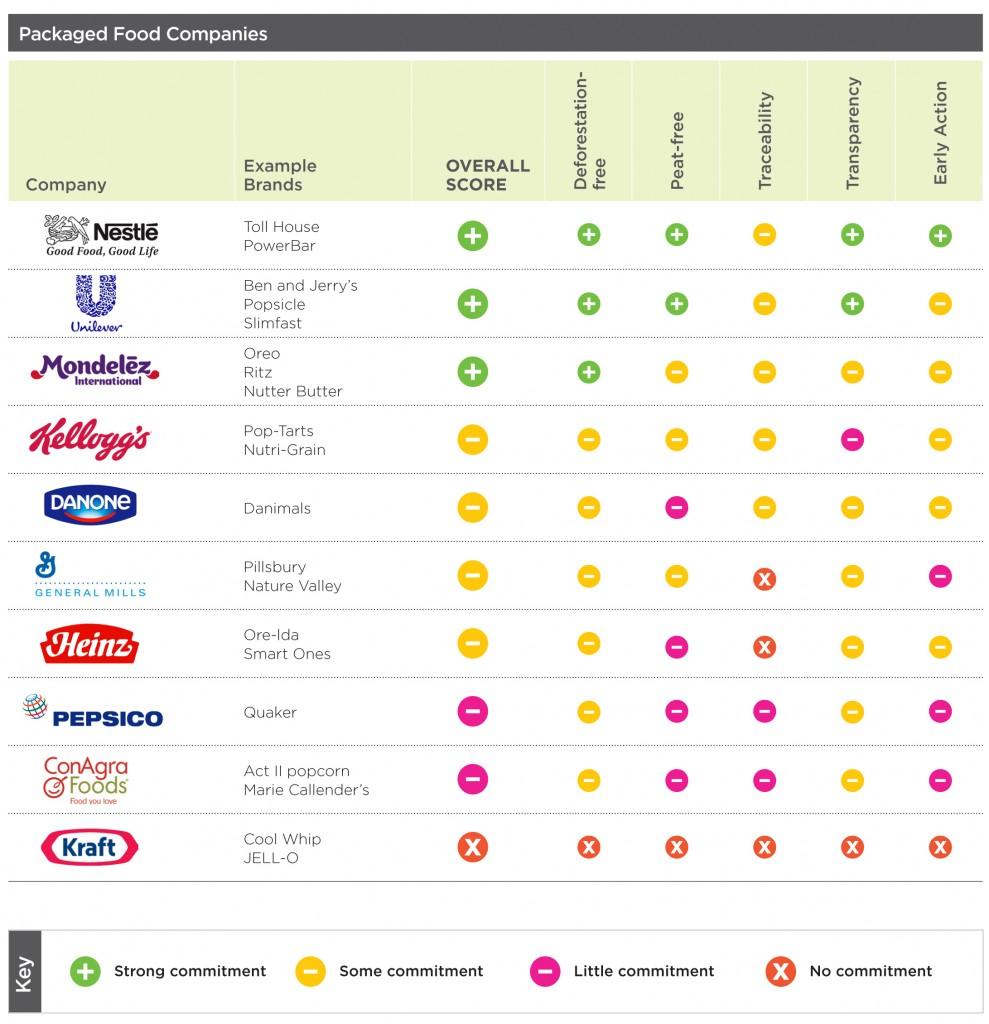

By Calen May-Tobin
Like most Americans, I’m really devoted to the products I buy. I’ve been using Old Spice since I was 15 and entered my “Frank Sinatra” phase, on a bad day nothing cheers me up quite like a bowl (or six) of Lucky Charms or Cinnamon Toast Crunch, and seeing a Taco Bell sign or McDonald’s golden arches on a long car trip never fails to reinvigorate me. For better or worse, we Americans have developed an attachment to these brands and the companies that make them.
So, as I delved into the commitments these companies have made to address palm-related deforestation and peatland destruction, I was disheartened to see how little some of the brands I love are doing to address the problem. That research was part of a project to score 30 top consumer companies in the fast food, personal care and packaged food sectors on their commitments to source deforestation- and peat-free palm oil. The report, which was released this week, shows that while a few companies are leading the way, most have a long way to go to fully address palm-related habitat destruction and climate emissions.
F is for fast food
Fast food menu items, like doughnuts, are sometimes prepared with palm oil.
Most of us realize that fast food isn’t great for our health, but I was shocked to see how bad it was for the health of our planet as well. The fast food sector was far and away the worst-scoring of the sectors we evaluated. Only two companies (McDonald’s and Subway) out of 10 had palm commitments which were strong enough to receive points, and even those companies were pretty low scoring. This means the palm oil that’s going into our Dunkin’ Donuts and McDonald’s apple pies is still likely driving the destruction of habitat for the endangered orangutans and tigers, and spewing millions of tons of carbon dioxide (the leading greenhouse gas) into the atmosphere.
Over-reliance on half-measures
On average, personal care companies scored better than the fast food sector. However, only two companies, L’Oréal and Reckitt Benckiser (which makes Clearasil and other products), have committed to buying traceable deforestation- and peat-free palm oil. Many of the other companies rely on the Roundtable on Sustainable Palm Oil (RSPO) standards to meet their palm oil commitments. I’ve written before on the limitations of the RSPO to address deforestation and peatland conversion. Companies in all three sectors that currently rely on the RSPO need to go further in order to fully address the deforestation and peatland destruction associated with palm oil.
Leading the way but a long way to go
The packaged food sector has the strongest commitments overall. Four out of 10 companies (Kellogg’s, Mondelēz, Nestlé and Unilever) are leading the way with commitments to buy traceable deforestation- and peat-free palm oil. The rest of the companies in this sector have a lot of work to do to catch up with the leaders.
Even those companies that have made strong commitments, however, still have a long road ahead of them. Commitments are only the first step, and are only as good as the paper they’re printed on. The real change takes place when companies act on their commitments and put them into practice. A journey might start with a single step, but you’ll never reach your destination if you don’t take the rest of them.
Consumers speak, companies listen
What can you do to make companies change their ways? The best thing you can do is demand that these companies take deforestation off their ingredients list. We know from experience that when consumers talk, companies listen. For example, back in 2010 consumers and NGOs organized a massive campaign against Nestlé, after it was linked to deforestation and other problems related to the palm oil it used. As a direct result Nestlé now has the strongest palm oil commitment out there.
Does this mean you should stop buying products with palm oil? The short answer is “No.” The longer answer can be found in this post. It’s more effective to pressure companies than it is to change global buying habits.
So, let’s make sure we can buy our favorite products without feeling a pang of guilt and demand that ALL companies stop buying palm oil that destroys forests and peatland. Based on our review of 30 companies, UCS has chosen six of the largest palm oil buyers in the fast food, personal care, and packaged food sectors that have the ability to help move the entire industry—if they act now. We need your help to convince these big brands to take palm oil seriously. Visit www.ucsusa.org/palmoilaction to send a message to the companies demanding that they do better.
Sabah, Malaysia Image: Rhett Butler
Charts courtesy of the Union of Concerned Scientists
A version of this post originally appeared on the Union of Concerned Scientists "The Equation" blog
Calen May-Tobin is a policy analyst for the Union of Concerned Scientists with expertise reducing emissions from tropical deforestation and degradation. He holds a Master’s degree in ecology from the University of California, Irvine. See Calen's full bio.
Can California Make Drug Manufacturers Pay for Take-back?


Leftover prescription and over-the-counter drugs flushed down the toilet or tossed in the garbage can end up in oceans and waterways, polluting the environment and threatening human health. Cash-strapped jurisdictions across California have come up with a patchwork of programs to collect and safely dispose of these medications, but now one state senator is proposing a statewide solution with a more reliable funding source, introducing legislation that would require the pharmaceutical industry to finance and manage drug disposal across the Golden State.
Under Senate Bill 1014, drug manufacturers would be obligated to design, pay for and administer a statewide program to collect their products from consumers at no charge and to dispose of drugs by safe, environmentally responsible means. After submitting a stewardship plan describing their program model and plan of operation to state waste management agency CalRecycle for approval, drug makers would implement the program and report back to CalRecycle annually. CalRecycle would require a review and update to the stewardship plan every three years.
The bill, introduced by State Senator Hannah-Beth Jackson (D-Santa Barbara), is modeled after similar industry-funded programs in Europe and Canada. For the past 15 years in parts of Canada, the pharmaceutical industry has paid for a successful initiative that collects unused medication in bins placed at local pharmacies.
These corporate-financed take-back programs are based on the principles of extended producer responsibility (EPR): a model of product stewardship that requires the manufacturers of a product to take responsibility for the environmental and social impacts of its product throughout the product’s lifecycle – from sourcing the material and production to consumer use and disposal. In addition to relieving governments and taxpayers from the high costs of product disposal, the ultimate goal of EPR is to motivate manufacturers to make their products in a more environmentally and socially responsible way because they are compelled to confront the externalities of their operations.
How will an EPR model of waste management achieve a more successful collection program for old drugs than the programs in place? While local governments have stepped up to plate to try to set up medication disposal options with their limited budgets, the supply of leftover drugs and demand for disposal options far exceeds the current infrastructure, Jackson said in a statement. There are only 305 disposal sites across the state to serve 38 million Californians.
SB 1014’s take-back program is expected to increase the amount of disposal sites for leftover medication and give every Californian access to drug disposal options -- because the program wouldn’t rely on local governments’ scant resources to operate. Californians will be more likely to learn about a statewide program promoted by a corporate-financed outreach campaign than they are likely to find out about their city’s program – if one exists. According to a fact sheet produced by Jackson’s office, public surveys across Canada indicate a strong awareness and participation in the country’s pharmaceutical take-back program.
“[The California Product Stewardship Council] supports SB 1014 because the public is demanding that there be a statewide medicine collection program for a variety of reasons including public and environmental health, and the policy solution the bill offers is business friendly, cost-effective, convenient to the public and proven to work with over 15 years of operations in Canada,” said Heidi Sanborn, executive director of the California Product Stewardship Council, one of the bill’s sponsors.
Will drug manufacturers embrace the proposed legislation? SB 1014 supporters say the bill is actually business-friendly, allowing the industry to design the collection program in the most efficient, cost-effective way to the companies, with only minimal oversight from state regulators.
But, despite paying for similar programs in Canada and Europe, drug makers will likely push back against SB 1014. Three pharmaceutical associations sued Alameda County when it passed a comparable ordinance requiring drug companies to set up a take-back program for its constituents. The county prevailed in trial court, and the case is now being considered by the Ninth Circuit Court of Appeals.
SB 1014 is sponsored by the California Product Stewardship Council, Clean Water Action, the California Alliance of Retired Americans, the City and County of San Francisco, and Alameda County. The bill will be heard by the state Senate’s Environmental Quality Committee at the end of the month before it moves to the Business and Professions Committee.
Image credit: Flickr/Carly Lesser & Art Drauglis
Passionate about both writing and sustainability, Alexis Petru is freelance journalist based in the San Francisco Bay Area whose work has appeared on Earth911, Huffington Post and Patch.com. Prior to working as a writer, she coordinated environmental programs for Bay Area cities and counties. Connect with Alexis on Twitter at @alexispetru
Investment Fund Launches Model For Energy Efficiency Financing
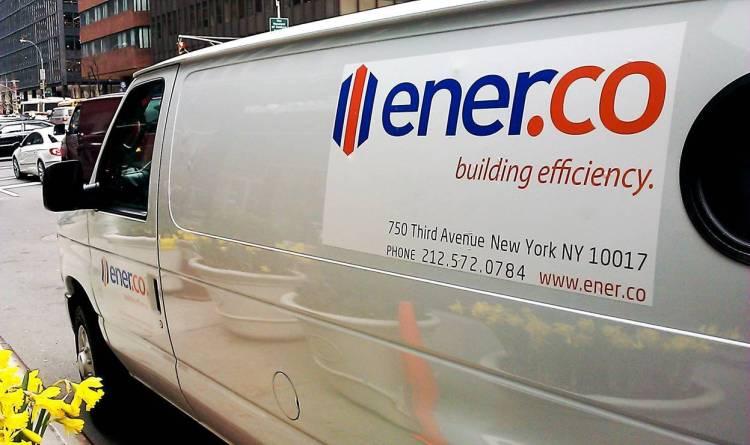

According to the EPA, buildings in the U.S. account for 36 percent of total energy used in the country and 65 percent of all electricity consumption, so any improvements in building energy efficiency that can be made provide a tremendous opportunity for huge benefits. That said, when it comes to energy, funding has tended to flow more freely towards renewable energy generation projects than towards energy efficiency projects -- effectively creating a barrier to necessary work, which would otherwise make the country's buildings far greener.
One energy efficiency and demand response financier is seeking to address this problem. "What is missing in the energy efficiency industry is akin to what is allowing solar to take off now," says Mike Gordon, CEO of Joule Assets Inc, "There has been no ability to create investments, which can be re-bundled and sold to investors down the line."
By doing just this, Joule Assets plans to correct the shortfall in energy efficiency projects by providing access to the necessary financing that will allow small- and medium-size contractors to unlock the potential in the market for energy efficiency work.
Part of the reason for a lack of funding thus far is one of scale. Investment in multi-million dollar renewable energy generation projects -- such as commercial solar installations -- has been available, because the potential for large profits to pour in have made it worthwhile for financial institutions to set up and service the loans necessary to build them. But, says Joule Assets' Gordon, "Energy efficiency projects at $250,000 or $750,000, don't have access to the financing that big projects do, because banks won't check credit extensively for projects of this [smaller] size in the same way as they will for multimillion dollar projects." The result being that projects in the order of magnitude of hundreds of thousands of dollars often remain without finance.
Since many energy efficiency retrofit projects fall into this size of capital expenditure, Joule Assets believes that what is needed is for small- and medium-size contractors to be able to deploy dollars at their own discretion on projects of this magnitude -- thereby making financing available to their customers for the energy efficiency work they undertake. Joule Assets provides the structure which allows them to do that, but in order to prevent contractors taking on projects that are not going to pay, the incentive for making wise decisions derives from the fact that contractors are subject to a loan-loss reserve -- effectively a share in some risk. It's a fair arrangement though; while contractors are on the hook for some liability if the project doesn't pay, they get access to financing that they would not be able to secure on their own, and in turn, a larger order pipeline.
Investors are backing Joule Assets benefit too, because typically the payback on energy efficiency projects is faster than investments in renewable energy. Furthermore, Joule Assets' Gordon asserts, their fund also offers an opportunity for better-than-normal returns since they have built software and a database which identifies all the extra value available in any given project. Here's an example:
Say an energy efficiency project allows a company to avoid paying for energy at times of peak demand. As well as the building owner getting an immediate saving in kilowatt-hours used, they can also, Gordon explains, secure a certificate of registration for this peak energy demand reduction, and sell that into the electricity market for a period of 15 years. By doing so, additional dollars from the electricity markets enhance the project's overall value. Despite this opportunity, however, few building owners are actually taking advantage of it, or even know how to go about it -- meaning much of the time, money is left on the table. Joule Assets helps identify and complete the registration for such opportunities, while taking a portion of the value realized, as a service.
Gordon explains the goal as an investment fund is threefold: Provide investors with a secure return, provide them with better than normal returns, and by dealing with regulators, create markets that allow a social benefit to be realized efficiently; in this case, that of energy reduction.
At launch, Joule Assets is working with Ener.co, an HVAC contractor that has a coating technology for air conditioning condensers which reduces power consumption by 15 percent on average. This could save a big-box store owner, for example, hundreds of thousands of dollars over 10 years at a single location, for a project with an average pay-back period, according to the company, of 1.5 years. By the end of the year, Joule Assets expects to be working with around 20 different contractors.
Image used with permission
Follow me on Twitter: @PhilCovBlog
Chipotle Identifies Climate Change As a Risk, Warns It May Stop Serving Guacamole


Chipotle’s recent SEC filing caused quite a stir. Specifically, one of the risks stated in that filing caused a stir.
The company cited “changes associated with global climate change” as having a potential “significant impact on the price or availability of some of our ingredients.” Due to cost increases, Chipotle “may choose to temporarily suspend serving menu items, such as guacamole or one or more of our salsas.” However, Chipotle spokesperson, Chris Arnold downplays that specific example. “It’s routine financial disclosure,” Arnold told Think Progress. “Nothing more than that.”
Chipotle may or may not have to suspend serving such staples of its menu as guacamole and salsas. However, chances are great that climate change will have an effect on the fast food chain. The filing also mentioned that weather events “such as freezes or drought” could lead to temporary price increases on certain ingredients. The filing goes on to mention drought. “For instance, two years of drought conditions in parts of the U.S. have resulted in significant increases in beef prices during late 2013 and early 2014.”
California is in the midst of a three-year drought, and this drought is an historic one. Two scientists studied tree rings and found that the last time California had a drought this severe was 500 years ago. As a major agricultural state, California produces almost half of all fruit, nuts and vegetables grown in the U.S. Due to the ongoing drought, California farmers were told not to expect any water deliveries which means that to irrigate their crops they will be tapping ground water. If drought conditions continue, groundwater levels in California are likely to reach historic lows.
The U.S. Department of Agriculture (USDA) released a report last year on the potential effects of climate change on agriculture. As the report makes it clear, climate change will affect agriculture. Temperature increases and more variable rainfall “will reduce productivity of crops.” Although effects will vary in various regions in the U.S., “all production systems will be affected to some degree by climate change.” The USDA is not the only federal agency to detail potential climate change effects on agriculture. The EPA cites both droughts and floods as posing challenges for farmers and ranchers. Both the USDA and EPA point out that farmers and ranchers need reliable sources of water, and drought puts stress on water supplies.
Chipotle is not the only company to recognize that climate change poses a risk to its operations. The CDP, formerly known as Carbon Disclosure Project, released a report last September which looked at the risks of climate change to the supply chain. The report is based on the responses of 2,415 suppliers to a survey. In fact, 52 of the 54 CDP supply chain members responded to the survey, and they represent a combined spending power of almost $1 trillion. The majority (70 percent) of the respondents identified either a current or future risk related to climate change. Over half of the supply chain risks identified due to drought and rainfall extremes are already affecting the respondents’ operations or are expected to have an effect within the next five years.
Image credit: Flickr/foleymo
RGGI Completes First Cap-and-Trade Auction Since Reducing CO2 Cap by 45 Percent
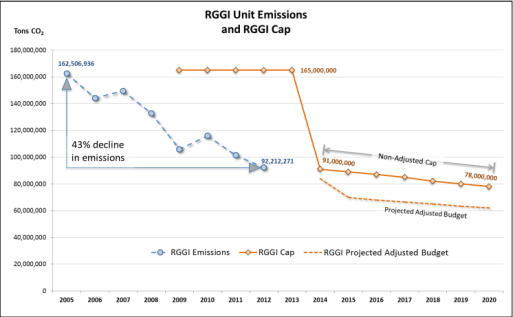

Extreme, atypical weather continues to take an unusually heavy toll on the U.S. economy and society this winter, patterns consistent with forecasts made by the world's leading climate scientists. Those same scientists have been urging world leaders to take action and proactively invest in climate change mitigation and adaptation initiatives for at least two decades.
When it comes to mitigating climate change, reducing carbon and greenhouse gas (GHG) emissions is paramount. Here in the U.S. in 2009, a total of nine Northeastern and Mid-Atlantic states joined in launching the Regional Greenhouse Gas Initiative (RGGI), a power sector emissions cap-and-trade market whereby the proceeds of emissions allowance auctions are invested in energy efficiency, renewable energy and other programs of benefit to consumers.
On March 5, RGGI completed its 23rd auction of CO2 allowances -- the first since a new, much lower cap on CO2 emissions from the region's power plants (those with capacity of 25 MW or more) was set in January. This year's emissions cap of 91 million tons of CO2 is 45 percent lower than last year's limit of 165 million.
RGGI CO2 emissions reductions back on track
Why such a drastic reduction in this year's CO2 emissions cap? As Jeff Spross of Climate Progress explains in a March 7 post, a flatlining secondary market price prompted the RGGI board to take action.
“Starting in 2010, the cost of the permits in RGGI’s auctions flatlined at just under $2 per ton. At such a low price, the incentive to cut was low-to-nonexistent — a sign that RGGI’s cap was so high it wasn’t reducing carbon emissions beyond what business-as-usual would’ve done.”
The results of the March 5 auction were encouraging. RGGI auctioned more than 23.491 million CO2 allowances at a clearing price of $4 per allowance, according to an RGGI press release.
The total sold included all 18.491 million allowances offered for sale by the nine RGGI states plus the entire 5 million cost containment reserve (CCR) allowances allocated for 2014. CCR allowances are only available for sale if CO2 allowance prices exceed certain levels each year ($4 for 2014).
As Kenneth Kimmell, chair of the RGGI board of directors and commissioner of the Massachusetts Department of Environmental Protection, elaborated:
“The results are what we expected—there was an increase in the allowance price, all the allowances we offered were sold, and the CCR operated as intended. These early results demonstrate RGGI is on track to reduce carbon emissions by 80-90 million tons through 2020 while helping states fund clean energy investments.”
More Than $2 Billion in Lifetime Energy Bill Savings
The March 5 auction generated $93.96 million in proceeds that will now be available to RGGI states for investment in a variety of beneficial energy initiatives, including energy efficiency, renewable energy, direct bill assistance, and greenhouse gas abatement programs, RGGI highlights. Cumulatively, RGGI auctions have yielded more than $1.6 billion for reinvestment.
Added Collin O'Mara, RGGI board vice-chair and secretary of the Delaware Department of Natural Resources and Environmental Control:
“Our first auction under the new cap demonstrates how market-based programs cost-effectively reduce carbon pollution while driving investments in a clean energy economy. Our recently released Regional Investment of RGGI CO2 Allowance Proceeds, 2012, estimates that RGGI proceed investments will return more than $2 billion in lifetime energy bill savings to more than 3 million participating households and more than 12,000 businesses in our region.”Image credit Baltimore Building & Construction Trades Council
*Graphs credit RGGI
Big Ben May Get a Solar Face Lift

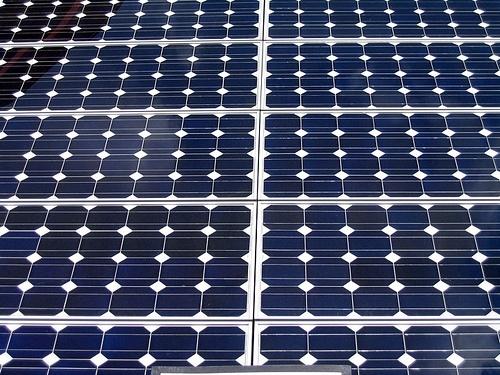
In an effort by the U.K. Parliament to reach the ambitious goal of reducing greenhouse gas emission by 34 percent by 2020, the House of Commons is now looking to the parliamentary estate and considering installing solar panels on the face of Big Ben in London. Parliamentary passholders were submitting ideas for reducing carbon emissions and boosting energy efficiency on the estate, when the solar idea was suggested.
Big Ben, officially renamed the Elizabeth Tower in 2012, was constructed in 1859 and contains 6.9-meter clocks on a 96-meter tower. It is located on the north end of the Palace of Westminster and has become one of the most prominent symbols of the United Kingdom, particularly in visual media and the chimes in audio media. It is a popular landmark in the United Kingdom, thus installing solar panels would be an iconic gesture.
Other energy efficiency estate plans include insulating the Palace of Westminster roof with sheep wool -- a material that has been found to significantly reduce heat loss, while preventing leaks. Several green initiatives are underway this year, such as installing voltage optimization technology to mitigate wasted energy, identifying energy efficiency improvements for all estate buildings, and replacing light bulbs with LEDs. Parliament has already reduced waste water and increased recycling.
The Climate Change Act of 2008 set legally binding greenhouse gas emissions targets for the United Kingdom of at least a 34 percent reduction below 1990 levels by 2020 and an 80 percent reduction by 2050. The government has been on track to meet its first three carbon budgets, says Energy Secretary Ed Davey, which is very impressive given the scope of the goal. Such a significant carbon reduction initiative is a huge task, which has been partially obscured by sluggish economic growth.
“The U.K. takes its obligations under the Climate Change Act to cut emissions by 80 percent by 2050 extremely seriously,” Davey said in a statement. “As the world’s most prominent climate scientists have said, we must not rest on our laurels if we want to avoid dangerous climate change.”
The government will have to increase the speed of its emissions-reduction efforts by a factor of four to continue to meet future targets, which is an ambitious goal. The United Kingdom has committed to decarbonizing its energy supply, which is vital given that the sector generated an estimated 40 percent of the country's emissions in 2012. The United Kingdom has become a leader in offshore wind energy production to assist in this goal.
Overall, solar energy growth in 2014 is expected to be strong in the United Kingdom, at an estimated 2.5 GW of additional capacity, compared to an estimated 6 GW in the U.S. This could make the United Kingdom the leading European solar photovoltaic installer during 2014, which is a major feat. Several factors shaping the solar market are lower solar panel costs, a slow German market and high acceptance rates for large photovoltaic projects.
This potentially iconic solar installation on Big Ben may in fact be frosting on the cake for a larger greenhouse gas reduction movement in the United Kingdom.
Image credit: Flickr/Rachel Hobday and kevinthoule
Sarah Lozanova is a regular contributor to environmental and energy publications and websites, including Mother Earth Living, Green Building & Design, Triple Pundit, Urban Farm, and Solar Today. Her experience includes work with small-scale solar energy installations and utility-scale wind farms. She earned an MBA in sustainable management from the Presidio Graduate School and she resides in Belfast Cohousing & Ecovillage in Midcoast Maine with her husband and two children.
Women in CSR: Alice Korngold, Korngold Consulting

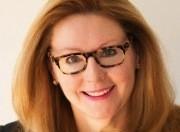
Welcome to our series of interviews with leading female CSR practitioners where we are learning about what inspires these women and how they found their way to careers in sustainability. Read the rest of the series here.
TriplePundit: Briefly describe your role and responsibilities, and how many years you have been in the business.
Alice Korngold: I am President and CEO of Korngold Consulting. Together with members of my team, I assist companies in establishing NGO/nonprofit board-matching programs that help them to achieve their objectives for corporate growth and profits through leadership development, stakeholder engagement and productive NGO/nonprofit partnerships. We also train and place corporate executives on NGO/nonprofit boards of directors based on each individual’s interests and qualifications and the needs of each NGO/nonprofit.
Additionally, we consult to the boards of directors of global, national, and regional NGOs/nonprofits—including addressing board composition, recruitment, and leadership succession planning—to advance NGOs/nonprofits in achieving their greater ambitions and long-term sustainability.
I’ve been working in CSR since 1993, when I founded, built and ran a social enterprise in Cleveland, Ohio to provide CSR advisory services to corporations, in addition to nonprofit board-matching services for over 1,000 corporate executives and board development services to several hundred nonprofits. Our organization also trained and advised leadership programs in other cities, throughout the country, seeking to replicate our nonprofit board-matching model, which was financially self-sustaining through fees for services.
In 2005, I returned home to NYC to establish a consulting firm to provide CSR and board-matching services to global corporations, and nonprofit board consulting services to global, national, and regional NGOs/nonprofits.
I published numerous CSR and board governance chapters and articles since the early 90s, followed by two books. The first book was Leveraging Good Will: Strengthening Nonprofits by Engaging Businesses (Jossey-Bass, a Wiley Imprint, 2005). The second, quite recently, is A Better World, Inc.: How Companies Profit by Solving Global Problems…Where Governments Cannot (Palgrave Macmillan, 2014).
3p: How has the sustainability program evolved at your company?
AK: Through experience: Our approach with each client, whether for-profit or nonprofit, is to help them to envision their greatest potential—often gathering input from a variety of stakeholders. Then we assist our clients in finding innovative ways to maximize success; to do so, we often help to facilitate partnerships between companies and NGOs/nonprofits, stakeholder engagement, and effective board governance.
Success for each company is defined by its ability to reduce costs, mitigate risks, increase profits, and build long term value. Success for each NGO/nonprofit is defined by its ability to achieve its mission, while building financial sustainability. Both for-profits and NGOs/nonprofits achieve the best results, strategically and financially, by finding solutions to the world’s greatest challenges—economic, social, and environmental.
Through research: Based on research for chapters and articles as well as for my recent book, A Better World, Inc.: How Companies Profit by Solving Global Problems…Where Governments Cannot. Our research shows that leading companies are profiting by solving the world’s greatest economic, social, and environmental problems. Additionally, our research reveals that corporate-NGO partnerships, stakeholder engagement, and effective board governance are essential for success.
Our consulting experience and research informs how we develop and deliver services to help our clients to achieve their highest aspirations.
3p: Tell us about someone (mentor, sponsor, friend, hero) who affected your sustainability journey, and how.
AK: There isn’t one person. Rather, my sustainability journey has been and continues to be deeply affected by the many business and NGO/nonprofit people with whom I work, not only in a consulting capacity, but also in the context of blogging. Blogging is merely a sideline for me, a voluntary activity to learn about and showcase companies and NGOs/nonprofits that are modeling best practices in corporate-NGO partnerships or board governance. Many of the best examples have come out of the annual meetings of the Clinton Global Initiative (CGI), which I’ve been covering for Fast Company since 2008, and where I’ve ultimately had the opportunity to be a moderator and panelist.
The sustainability journey is really about trying to understand the challenges and opportunities facing the companies and NGOs/nonprofits with which I work, and helping them to find ways to work together to solve global problems. The best solutions benefit companies and NGOs in achieving success, while also helping to build a better world.
3p: What is the best advice you have ever received?
AK: Inspirational words I remember often were spoken by Reverend Peter J. Gomes in June 1997:
“God, grant me work until my life is over, and life until my work is done.”
3p: Can you share a recent accomplishment you are especially proud of?
AK: The publication of A Better World, Inc.: How Companies Profit by Solving Global Problems…Where Governments Cannot (Palgrave Macmillan, 2014) represents the culmination of 20+ years of CSR consulting experience in addition to an intense period of research and learning to prepare the book.
3p: If you had the power to make one major change at your company or in your industry, what would it be?
AK: The biggest change I’d like to see is greater diversity on the boards of multinational corporations: having people with diverse backgrounds, perspectives nationalities, gender, and cultures, as well as a variety of areas of expertise and experience. When that is achieved, companies will truly unleash their greatest potential in profiting by solving global problems.
3p: Describe your perfect day.
AK: In a perfect work day, I am meeting with the board of directors of an NGO/nonprofit where our work together is culminating in their decision to transition to new approaches to achieve more ambitious goals. At lunch, I am meeting with the leadership of a multinational corporation where our work together is culminating in their decision to invest in an NGO/nonprofit board matching program that will support the company in achieving its ambitious plans for growth. In the afternoon, I’m speaking passionately to a group of corporate and NGO/nonprofit leaders about A Better World, Inc.: How Companies Profit by Solving Global Problems…Where Governments Cannot to reinforce their work together and encourage them to forge ahead. In the evening, I’m having drinks with a corporate executive whom I placed on an NGO board two years prior to discuss her decision to step up to become chair of the board.
Learn to Feel the Planet's Pain: Sustainability Lessons from a Medical Missionary


By Herman Daly
Dr. Paul Brand grew up in South India as the son of British missionary parents. He returned to England to study medicine, then went back to take care of people with leprosy in India, mainly doing reconstructive hand and foot surgery — some 3,000 operations over many years. He also spent some time in Ethiopia doing similar things, and finally ended up as director of the only leprosy hospital in the U.S., located in Carville, La. I believe that hospital closed about 10 years ago, after Dr. Brand retired. He died in 2003.
His son happened to be a student of mine at Louisiana State University (LSU). Medically, he is credited with having established that leprosy is not the direct cause of decay or necrosis of the hands and feet universally observed in people with leprosy. Rather the damage to extremities is self-inflicted, resulting from the loss of sensation and inability to feel pain. Without pain there is no feedback to tell you that you are damaging yourself. Brand developed routines and practices to help avoid self-inflicted injuries, and wrote a book entitled "Pain: the Gift that Nobody Wants." He also wrote the standard medical textbook on hand and foot surgery.
LSU is a big football school, and an assistant coach invented a super-cushioned helmet that much reduced head pain on impact. This was thought a great thing until Dr. Brand pointed out that head pain was what kept football players from breaking their necks. Would you rather have a headache or a broken neck?
So much for background. I want to focus on a paragraph that Dr. Brand wrote in 1985:
"I would gladly give up medicine tomorrow if by so doing I could have some influence on policy with regard to mud and soil. The world will die from lack of pure water and soil long before it will die from a lack of antibiotics or surgical skill and knowledge. But what can be done if the destroyers of our earth know what they are doing and do it still? What can be done if people really believe that free enterprise has to mean absolute lack of restraint on those who have no care for the future?"
What led him to such a statement? Living in India, Ethiopia and Louisiana — and witnessing the same thing in each place.
In India he received his first lesson in soil management at age 6, from an old Indian farmer who reprimanded him and some other boys who carelessly broke the little turf dams on the terraced rice paddies along the mountain side while chasing frogs. The old man scooped up a handful of mud and said: "This soil will feed my family year after year. But the soil has to stay up here. The water wants to carry the soil down the mountain to the river, and then to the sea. Do you think the water will bring it back up?"
"No," they answered.
"Will you be able to bring it back up?"
"No, grandfather."
"Will rocky hillsides without soil feed my family?"
"No."
"Well, that is why the dams must be cared for. Do you understand?"
"Yes, grandfather," the boys said. "We’re sorry."
Returning to this area many years later Brand observed barren rocky hillsides — the result of government programs to use ex-prisoners to grow potatoes, but without first teaching them the wisdom of the old farmer.
In Ethiopia most of his leprosy patients were farmers, and that brought him again to the farms where he witnessed terrible erosion where there had once been trees and grasses. The Nile carried Ethiopian soil to Egypt. Farms grew poor crops, and the fields were full of large stones. But the stones were not so large that they could not be levered up and rolled to the edge of the field where they could have made useful walls instead of obstacles to tilling and harvesting. Why were such simple improvements not made, Brand asked. The peasants explained that if they made their fields look good and productive they would lose them to the ruling class. Someone from the city would claim that his ancestors had owned it, and the peasants had no chance in court. So injustice, as well as water and wind, contributed to erosion of the soil. People with leprosy who returned to the eroded farms did not have a good prognosis even if their leprosy was now under control.
The leprosarium at Carville, La, was just a stone’s throw from the Mississippi River. It dated from before levies had been built to contain the river. Therefore all the buildings and houses were built on stilts — maybe 4 to 8 feet high. For a week or so each year water swirled under your house, but you got around in a skiff or pirogue. (Nowadays a fiberglass bass boat with a 200 horsepower Mercury outboard engine is the standard mode of transportation in Louisiana bayous.) Meanwhile the water deposited its silt before returning to its banks, transferring Midwestern topsoil to the Louisiana delta or rebuilding the eroding marshlands or barrier islands. Now the river is contained between levies to eliminate annual floods, so the silt is deposited in the river bottom rather than on the land, necessitating higher levies. Or the silt flows all the way out into the Gulf of Mexico and over the continental shelf, no longer rebuilding coastal marshlands that are now disappearing — and would have served New Orleans as a buffer against Hurricane Katrina. In addition to silt, the Mississippi carries fertilizer and pesticide runoff from Midwestern farms into the Gulf, creating a dead zone the size of New Jersey. “Cheap” corn and soybeans do not include the costs of lost seafood in the Gulf.
So in light of these experiences in Dr. Brand’s life, let us reread the first part of his statement:
"I would gladly give up medicine tomorrow if by so doing I could have some influence on policy with regard to mud and soil. The world will die from lack of pure water and soil long before it will die from a lack of antibiotics or surgical skill and knowledge."
A physician treats our internal organs — heart, lungs, liver, kidneys, etc. in order that we may live longer and better. But our lives depend on external organs as well, environmental life support systems. What good are our lungs if there are no trees and grasses capable of photosynthesis? What good is our digestive tract if the land won’t grow food? What good are our kidneys if the rivers run dry, or are toxic? I think it is not much of a stretch for a good physician to realize that health and wellness now depend as much on care of our collective external organs as on our individual internal organs. Reconstructing a patient’s hands and feet, and then sending him to slowly starve on eroded farmland is at best a partial cure.
The other part of Dr. Brand’s statement, his questions, is also important:
"But what can be done if the destroyers of our earth know what they are doing and do it still? What can be done if people really believe that free enterprise has to mean absolute lack of restraint on those who have no care for the future?"
Environmental destruction, like other sins, is not just the result of ignorance. There is ignorance to be sure, but mostly we know what we are doing. We are caught up in structures that demand fast growth, rapid turnover, and quick profits. And that is facilitated both by ignorance of environmental costs, and by willingness to shift those costs on to others. Simple denial also plays a role — pie-in-the-sky savior fantasies of space colonization and belief in perpetual motion schemes — technological Gnosticism, I call it.
We all seem to suffer from a symptom of leprosy, we do not feel pain in our external organs and structures (our environmental extremities), and therefore do not stop the behavior that is damaging them. In part this is because often the benefits of the damaging behavior go to the people responsible for the behavior while the costs fall on others — the painful feedback is diverted to people who did not cause the damage. The fishermen in the Gulf of Mexico pay the cost of pesticide and fertilizer runoff caused by careless farming. Environmental costs have been shifted from those who caused them to those who did not.
It would be easy to say, “Well this is nothing new, just the same old prophets of doom in modern dress — there is nothing new under the sun.” But there is something new — the earth is now relatively full of us and all our stuff. In my lifetime world population has tripled, and the populations of livestock, automobiles, and refrigerators have vastly more than tripled. Meanwhile the size of the earth has stayed the same — so it is a lot more full. And the growing scale of the economy means that environmental and social cost-shifting is ever larger and more dangerous.
Consequently there are many more environmental problems than soil erosion. I focused on that because it was what led Dr. Brand to his realization. Other, newer environmental problems, many of them interrelated, include climate change, biodiversity loss, ozone layer depletion, overpopulation, oil depletion, etc. Not to mention modern warfare. I’ll spare you a complete litany.
Many environmentalists look at this list and despair. Humans, after all, they say, are just one more animal species and will over-consume and over-reproduce until they provoke a collapse — just like deer on an island or bacteria in a flask. But Christians like Dr. Brand, and other thoughtful people as well, cannot take that attitude. Yes, we are a part of the Creation, and share many commonalities with our fellow creatures, and we are kin to them by evolution. But we are inescapably the creature in charge — the one that bears the capability and responsibility of the imago Dei. Dr. Brand was an example and witness to that truth.
Photo by Alain